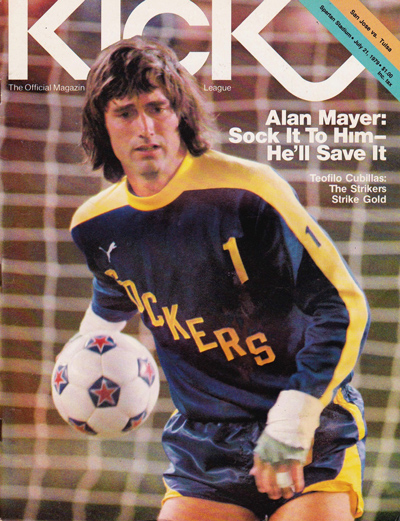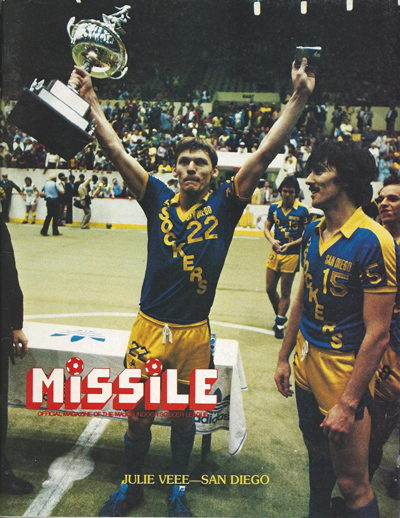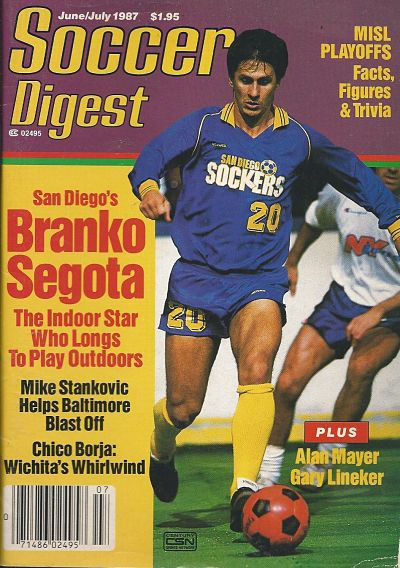North American Soccer League (1978-1984)
Major Indoor Soccer League (1982-1983 & 1984-1990)
Major Soccer League (1990-1992)
Continental Indoor Soccer League (1993-1996)
Tombstone
Born: December 21, 1977 – The Las Vegas Quicksilvers relocate to San Diego
Folded: May 16, 1997
First Game: April 2, 1978 (W 4-1 @ Vancouver Whitecaps)
Last Game: October 16, 1996 (L 10-5 @ Houston Hotshots)
NASL Soccer Bowl Championships: None
NASL Indoor Champions: 1982 & 1984
MISL Champions: 1983, 1985, 1986, 1988, 1989, 1990, 1991 & 1992
CISL Championships: None
Stadia
Outdoor Soccer:
Jack Murphy Stadium (22,222)11983 Official North American Soccer League Guide
Opened: 1967
Demolished: 2020-2021
Indoor Soccer:
San Diego Sports Arena (12,948)21984-85 Major Indoor Soccer League Media Guide
Opened: 1966
Marketing
Team Colors:
- 1982: Royal Blue & Gold31982 Official North American Soccer League Guide
- 1993-1996: Teal, Black & Purple41994 San Diego Sockers Media Guide
Television:
- 1984-85 (MISL): KUSI-TV (Channel 51)
- 1987-88 (MISL): Prime Ticket Network (Cable)
- 1991-92 (MSL): San Diego Cable Sports Network (SDCSN)
Television Broadcaster:
- 1984-85 (MISL): Randy Hahn
- 1987-88 (MISL): Randy Hahn (play-by-play) & Bill MacDonald (color)
- 1991-92 (MSL): Randy Hahn
Radio:
- 1978-1979 (NASL): KOGO (600 AM)
- 1984-85 (MISL): KOGO (600 AM)
- 1987-88 (MISL): XTRA (690 AM – English) & XEXX (1420 AM – Spanish, home games only)
- 1991-92 (MSL): KFMB (760 AM)
- 1994 (CISL): KCEO (1000 AM) & KGMG (1320 AM)
- 1995 (CISL): KCBQ (1170 AM)
Radio Broadcasters:
- 1978-1979 (NASL): Joe Starkey
- 1984-85 – 1991-92 (MISL): Randy Hahn
- 1987-88 (MISL): Alberto Estrada & Gustavo Lopez (XEXX – Spanish)
- 1991-92 (MSL): Tony Lovitt (split games with Randy Hahn)
Ownership
Owners:
- 1978-1984: Bob Bell
- 1984-1987: Bob Bell, Ron Fowler, et al.
- 1987-1991: Ron Fowler
- 1991-1994: Oscar Ancira, Sr.
- 1995-1996: Arena Group 2000 (Ron Hahn)
Sale (1984): $1.2 million for 24% stake
- Bob Bell sells 24% of the Sockers to a group of 11 investors, including future majority owner Ron Fowler and America’s Cup yachting champion Dennis Conner)5Maffei, John. “Bell tries to stay for boom”. The Times-Advocate (Escondido, CA). February 22, 1984
Bankruptcy (1988): The Sockers file for Chapter 11 Bankruptcy on April 25th, 1988.
Sale (1988): $470,000 for 100% stake
- Former Sockers owner Ron Fowler purchases the team from bankruptcy court)6Ello, Chris. “Judge OKs Fowler’s Bid for Sockers”. The Times (Los Angeles, CA). July 30, 1988
Attendance
Outdoors:
1981 was the peak year for Sockers outdoor attendance at Jack Murphy Stadium. It was also the only year that the Sockers outpaced the NASL’s league-wide average. In the final two seasons of the NASL, 1983 and 1984, the Sockers finished dead last in the league in announced attendance.
Tilting your mobile device may offer better viewing.
Source: Kenn.com Attendance Project
Trophy Case
NASL Indoor Most Valuable Player:
- 1981-82: Juli Veee
MISL/MSL Most Valuable Player:
- 1982-83: Alan Mayer
- 1984-85: Steve Zungul
- 1990-91: Victor Nogueira
- 1991-92: Victor Nogueira
MISL/MSL Goalkeeper of the Year:
- 1987-88: Zoltan Toth
- 1988-89: Victor Nogueira
- 1990-91: Victor Nogueira
- 1991-92: Victor Nogueira
MISL/MSL Defender of the Year:
- 1984-85: Kevin Crow
- 1987-88: Kevin Crow
- 1988-89: Kevin Crow
- 1990-91: Kevin Crow
- 1991-92: Kevin Crow
MSL Rookie of the Year:
- 1990-91: David Banks
CISL Rookie of the Year:
- 1994: John Olu Molomo
- 1995: Mark Chung
- 1996: Carlos Farias
MISL Coach of the Year:
- 1987-88: Ron Newman
Background
The greatest indoor soccer dynasty of all time started out as a struggling outdoor soccer team that couldn’t find a home. The franchise that would become the San Diego Sockers formed in Baltimore in 1974 as an expansion club in the North American Soccer League. Two unremarkable seasons later, the Baltimore Comets moved across the country to become the San Diego Jaws in 1976. After one year in San Diego, the team moved to Nevada and played a single season as the Las Vegas Quicksilvers in the summer of 1977.
Outdoor Bridesmaids
The team finally acquired stability when Robert W. Bell bought the Quicksilvers and returned the team to San Diego to begin play as the San Diego Sockers in the spring of 1978. Under Bell’s ownership, the Sockers played seven seasons of outdoor soccer in the NASL at Jack Murphy Stadium from 1978 to 1984. The team peaked in the years 1979 to 1982, reaching the playoff semi-final for four consecutive seasons. But the club always fell a single game short of the NASL’s Soccer Bowl title game.
The Sockers’ outdoor popularity crested in 1981, when average crowds reached 14,802 for 16 home matches. But attendance crashed badly in the following seasons. In 1982, San Diego was chosen as the host of Soccer Bowl ’82. It was risky move given the Sockers’ modest attendance history. For the fourth consecutive year, the Sockers lost in the semis, further reducing ticket sales interest for the final between the New York Cosmos and the Seattle Sounders on September 18, 1982. The announced attendance of 22,634 was termed “a disaster” by NASL CEO Howard Samuels.7Vecsey, George. “Sports Of The Times; The Soccer Bowl Not A Super Bowl.” The New York Times, September 19, 1982
By 1983, Sockers average attendance was down to a league-worst 4,685, a crash of 70% in just two seasons. During the late 1970’s, the New York Cosmos occasionally drew single game crowds that were larger than the Sockers’ total annual attendance for the 1983 and 1984 outdoor seasons.
Indoor Dynasty
But Bell kept the Sockers going, in part because of the club’s terrific success in the indoor game. The NASL began experimenting with a winter-time indoor season in 1979-80 in response to a threat from the rival Major Indoor Soccer League, which began play in 1978. Only a few clubs participated at first. NASL teams were slow to embrace the indoor game due to philosophical issues and labor disputes with the league’s player association. The Sockers played their first indoor season at the San Diego Sports Arena in the winter of 1980-81.
The Sockers won their first indoor title in the winter of 1981-82. That kicked off an amazing run of ten indoor titles in the next eleven years, as the Sockers became one of the all-time great American sports dynasties. The financially strapped NASL opted not to put on an indoor season in 1982-83, so the Sockers temporarily joined the rival Major Indoor Soccer League that winter and won the 1983 MISL title. In 1983-84, they returned for the NASL’s final indoor campaign and won that too, marking their third straight championship.
The NASL went out of business after the 1984 outdoor season and the Sockers joined the MISL on a full-time basis in the winter of 1984-85. The Sockers continued their dominance, winning the MISL Championship every year from 1985 to 1992, with the lone exception of 1987.
Financial Turmoil
Bob Bell continued to take a financial beating despite the team’s on-field success. The Sockers never turned an annual profit and Bell lost an estimated $9 million during his seasons as the Sockers’ managing general partner. In 1980, Bell owned 95% of the team. Due to steep losses in the outdoor season, he began taking on limited partners. By 1984, Bell’s ownership stake was diluted to less than 20% of the club’s shares. Bell finally exited the scene in 1987, handing the reigns to one of his limited partners, Ron Fowler.
Under Fowler, the team continued to dominate the MISL, but the club’s finances failed to improve. The Sockers filed for bankruptcy in April 1988, just as the MISL contracted from 11 to 7 clubs. Fowler re-purchased the team out of a contentious bankruptcy filing, which may also have saved the league itself. The Sockers went on to win another four titles after this brush with death. In June 1991, Fowler also gave up, selling the club to frozen foods entrepreneur Oscar Ancira, Sr. Under Ancira, the team would win its tenth and final indoor championship in the spring of 1992.
Final Years: The CISL
In July 1992 the MISL folded after fourteen seasons. The Sockers accepted an invitation to join the new Continental Indoor Soccer League, set to begin play in June 1993. The big change from the MISL was that the CISL would play in the summer. Many CISL franchises were owned and operated by arena management companies and NBA/NHL ownership groups who were looking to fill empty building dates during the summer months. The move to the CISL meant that the Sockers had to take a full year off between May 1992 and the debut of the new league in June 1993.
The Sockers made one last run at a championship in 1993. In the CISL championship series they faced the Dallas Sidekicks, a long-time rival from the MISL days who had also made the jump to the new league. (The Sidekicks were also the only team to interrupt the Sockers decade-long dominance in the 1980’s, winning the MISL championship in 1987.) The Sidekicks won the best-of-three series two games to one.
The End
By 1994, the charismatic foreign stars like Steve Zungul, Kaz Deyna, Juli Veee and Branko Segota who fueled the Sockers’ dynasty during the 1980’s were long gone. So was Head Coach Ron Newman, the architect of all ten of San Diego’s titles during his tenure from 1980 to 1993. Newman left after the first CISL season. San Diegans showed little interest for indoor soccer in the summer time. Attendance at the Sports Arena for all four Sockers seasons in the CISL was less than 6,000 per match. These were the worst figures since the team’s first season of indoor soccer back in the winter of 1980-81.
The team folded on the eve of the 1997 CISL season. At the time of their demise, the Sockers were the oldest continuously operating pro soccer franchise in the United States.
The Sockers brand name has been revived in San Diego on two occasions. Both reincarnations have been considerably lower-budget than the original version of the team. The current edition of the Sockers plays in the Major Arena Soccer League.
Trivia
Head Coach Ron Newman was the only member of the Sockers to earn all ten indoor championship rings that the team earned in the NASL and MISL between 1982 and 1992. Kevin Crow and Brian Quinn won the most rings (eight) among Sockers players.
Voices
“I didn’t have any idea indoor soccer would sell here, so I paid a $25,000 penalty to keep us out of indoor the first time the North American Soccer League formed an indoor league. I wanted to wait and see.”
– Bob Bell, Owner 1978-1987 (1985 San Diego Union/Soccer Digest Interview)8Center, Bill. “The Sockers Now Love The Great Indoors.” Soccer Digest. November 1985
San Diego Sockers Shop
Editor's Pick
Rock n' Roll Soccer
The Short Life and Fast Times of the North American Soccer League
by Ian Plenderleith
The North American Soccer League – at its peak in the late 1970s – presented soccer as performance, played by men with a bent for flair, hair and glamour. More than just Pelé and the New York Cosmos, it lured the biggest names of the world game like Johan Cruyff, Franz Beckenbauer, Eusebio, Gerd Müller and George Best to play the sport as it was meant to be played-without inhibition, to please the fans.
The first complete look at the ambitious, star-studded NASL, Rock ‘n’ Roll Soccer reveals how this precursor to modern soccer laid the foundations for the sport’s tremendous popularity in America today.
When you make a purchase through an affiliate link like this one, Fun While It Lasted earns a commission at no additional cost to you. Thanks for your support!
San Diego Sockers Video
Sockers vs. New York Cosmos at Jack Murphy Stadium. 1982 NASL playoffs.
The Great Indoors: The Story of the San Diego Sockers 1980’s promo video
In Memoriam
Kaz Deyna (Sockers ’81-’87), a former Polish Olympic gold medalist who was part of five indoor championship with the club, died in a single-car DUI accident in San Diego on September 1, 1989. Deyna was 41. Los Angeles Times obituary.
Keith Weller served as an assistant to Head Coach Ron Newman during the Sockers’ 1988-89 MISL season, before getting the Tacoma Stars head job the following year. Weller died of cancer at age 58 on November 13, 2004.
Haitian striker Manu Sanon (Sockers ’80-’83) passed away on February 21, 2008 after a battle with pancreatic cancer.
Head Coach Ron Newman, architect of the Sockers’ 10 indoor championships, passed away on August 27, 2018. San Diego Union Tribune obituary.
Downloads
7-23-1980 Sockers vs. New York Cosmos Game Notes
7-23-1980 San Diego Sockers at New York Cosmos Game Notes
9-21-1981 Sockers vs. Chicago Sting Game Notes
2-7-1982 Sockers vs. Portland Timbers Indoor Game Notes
2-21-1982 Sockers vs. Vancouver Whitecaps NASL Indoor Playoffs Game Notes
5-12-1982 Sockers vs. New York Cosmos Game Notes
7-25-1982 Sockers @ New York Cosmos Game Notes
9-5-1982 Sockers @ New York Cosmos Game Notes
8-3-1983 Sockers @ New York Cosmos Game Notes
8-12-1984 Sockers vs. Tampa Bay Rowdies Game Notes
8-15-1984 Sockers @ New York Cosmos Game Notes
December 1986 Sockers Footnotes Newsletter
January 1987 Sockers Footnotes Newsletter
February 1987 Sockers Footnotes Newsletter
Links
###






2 Responses
The PASL version playing now is claiming the longest winning streak by a team in any U.S. pro sport. They’re using the term “pro” rather loosely, of course.
But the funny thing is that the streak was finally broken … by the revived Dallas Sidekicks!
Great stuff! Looking for video of 1981 Western Division final match San Diego Sockers v California Surf 5-2. Can you please help?